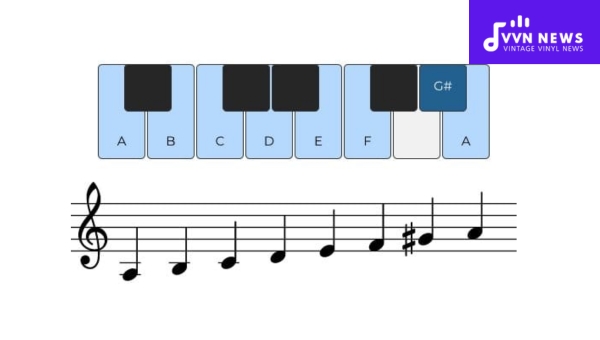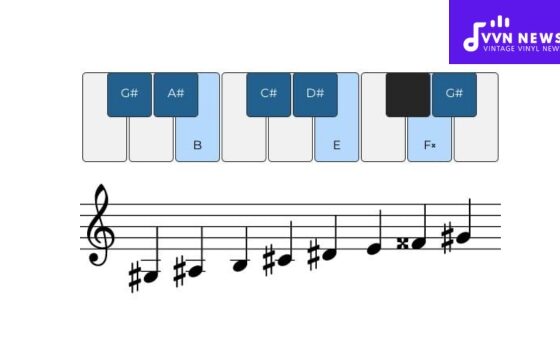In our journey of music discovery, we sometimes stumble upon aspects that defy the norm, yet become integral parts of the world’s rhythmic cadence.
One such intriguing detail is the A-harmonic minor scale. This particular scale, falling within the realm of minor scales, has an uncanny versatility that allows it to seamlessly blend into a wide array of musical genres.
Beginning your musical curriculum can be a daunting task, but these scales lay down a robust foundation for any aspiring musician. Like building blocks in construction, musical scales are paramount in constructing melodies and harmonies.
Just think about it: every song that ever moved you is a structured orchestration of these scales’ interplay, with the A-harmonic minor scale playing a starring role in many musical masterpieces.
A Harmonic Minor Scale Intervals
The specific sequence or order of the notes in a scale, known as intervals, gives each scale its unique sound.
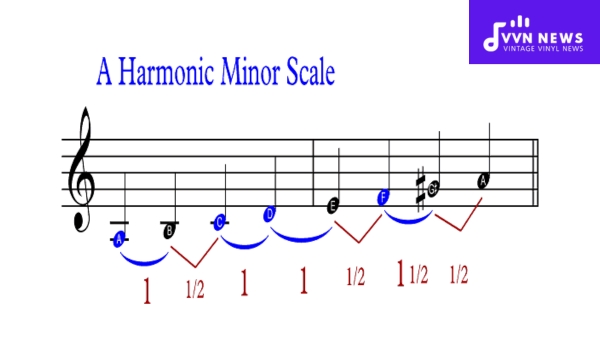
Music theory specifies these intervals for the A Harmonic Minor Scale as follows:
- From A to B is a Tone
- From B to C is a Semitone
- From C to D is another Tone
- Moving from D to E is again a Tone
- Between E and F there is a Semitone
- The transition from F through G# is an augmented 2nd
- The transition from G# back to A forms a Tone
These precise intervals create the distinctive feel of the A Harmonic Minor Scale, playing pivotal roles in your future compositions’ emotional impact and dynamics.
Also Read: Harmony In Music [Enhance Your Compositions With These Tips]
Harmonic Minor Scale Degrees
It’s essential to grasp the degrees of the A Harmonic minor scale for in-depth knowledge and applicability. The degrees represent the relative distance between individual notes in a scale, hence creating a distinctive pattern.
Here they are:
- 1st degree – A: This is our home base, the starting, and ending point.
- 2nd degree – B: One whole step away from the 1st Degree.
- 3rd degree – C: This is where things get interesting. The A Harmonic minor scale features a half-step here.
- 4th degree – D: From here, we move up another whole step.
- 5th degree – E: A vital note to remember as it’s used heavily in chord progressions within this scale.
- 6th degree – F: This note adds color and an exciting dynamic when used effectively. It’s another whole step up from E.
- 7th degree – G#: The G# in the A harmonic minor scale is what distinguishes it from other scales; it raises the 7th degree by half a step!
By spending time familiarizing yourself with these degrees, you will gain versatility and depth in your musical ventures. Consider these as cardinal points on your creative compass.
Also Read: F Sharp Major Triad [Enhance Your Musical Compositions]
The Modes of the A Harmonic Minor Scale
The A Harmonic Minor scale is not just a mere set of seven notes. It’s a complex entity that encompasses seven unique modes.
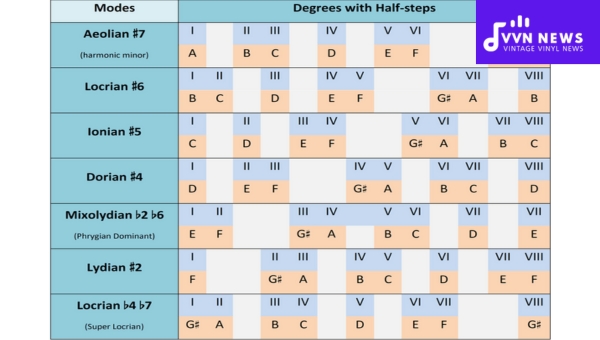
Each mode gives off its own “flavor” or characteristic sound, thanks to different intervals between the notes.
Aeolian ♯7
This is the first mode of the A harmonic minor scale, also referred to as Altered Aeolian or simply Harmonic Minor.
With an augmented seventh interval, this mode tends to convey feelings of melancholy or longing.
Its signature sound comes from the raised 7th note which induces a strong pull towards resolution on the tonic (the first note of the scale).
Locrian ♯6
In this second mode, known as Locrian ♯6, you encounter an altered Locrian with a raised sixth degree.
This makes it one of only two Locrian varieties with a natural 2nd and no 5th (diminished fifth), giving your music a less traditional yet surprisingly appealing sound.
Ionian ♯5
Shifting onto third gear, we have Ionian #5, alternatively recognized as Major #5 or Harmonic Major due to its configuration resembling a basic major scale but with an augmented fifth (♯5). This augmented anniversary adds an eccentric touch to your melody.
Altered Dorian
Our next stop in this minor harmonic highway leads us to Altered Dorian, widely known as Dorian #4.
This interesting mode introduces the augmented octave and ninth, giving melodies a mysterious allure that can truly take your compositions to another level.
Phrygian Dominant
A fan favorite among flamenco and rock musicians is Phrygian Dominant, also coined as Spanish Gypsy Scale thanks to its Middle Eastern vibe.
In essence, it’s like Phrygian but with a major third. This mode screams tension and release—a key ingredient in these genres.
Lydian ♯2
By transitioning to the Lydian #2 mode, you tap into an unusual source of musical expression due to its augmented second degree.
Its atypical structure offers unique rhythmic possibilities, perfect for artful experimentation.
Super Locrian bb7
Then we arrive at Super Locrian bb7. This is undoubtedly the most challenging mode of the A Harmonic Minor scale but also the most rewarding once mastered.
It boasts an array of augmented and diminished intervals that can create tension-filled landscapes in your music.
Learning these modes not only enriches your knowledge of musical theory but broadens your sonic palette for creating harmonies and melodies.
But remember to recall the saying that modes aren’t just scales; they’re a tool to create emotion, atmosphere, and mood.
Also Read: F Sharp Minor Pentatonic Scale [How To Use In Your Compositions]
Playing the A Harmonic Minor on Piano and Guitar
As you begin your experience with the intriguing A harmonic minor scale, remember, that familiarity with your instrument is key.
Be it the guitar fretboard or those black and white keys on your piano, achieving proficiency in this scale will catapult you to new realms of musical exploration.
On the Piano
To play the A harmonic minor scale on a piano, start on an ‘A’ note. Ascend seven steps of white keys to get to ‘G#, followed by a return to ‘A’.
It might seem simplistic at first glance, but let’s delve deeper into this process:
- Begin with your thumb (finger 1) on “A.”
- Follow this by striking ‘B’ using your index finger (finger 2).
- Next comes ‘C,’ played with the middle finger (finger 3).
- Thumb again under for “D.”
- Your index finger plays ‘E,’ followed by your middle finger bringing life to the ‘F’ note.
- Now comes a tricky part: use your ring finger (finger 4) to strike G#.
- Lastly, complete one octave by striking ‘A’ using your pinky finger (finger 5).
Just as waves ebb and flow, maintain fluidity in this process as you move from one note to another, weaving a fabric of harmonious sound.
On Guitar
Tackling the A harmonic minor scale on guitar may appear daunting initially, but many have tread this path before and found it rewarding.
With guitars having six strings named E-A-D-G-B-E (from thickest string to thinnest), here is precisely how you should proceed:
- Press down on the fifth fret of the low E string for “A.”
- Proceed to “B” at the seventh fret of the same string.
- Pick “C” at the eighth fret.
- Move to the fourth fret of A string for “D.”
- Strum “E” at the seventh fret.
- Repeat for “F” at the eighth fret.
- Play “G#” at the fourteenth fret of the D string.
- End one octave by hitting “A” on the twelfth fret of A
In your pursuit of mastering the A harmonic minor scale, remember sustaining regular practice is pivotal to your progress journey.
It is only with time and consistency that one can unlock the magic held within this tantalizing scale, creating spellbinding music that resonates in the hearts and minds of listeners.
A Harmonic Minor Key Signature
The A-harmonic minor scale is built on the key of A minor. Its key signature bears no sharps or flats – painting a congenial picture of simplicity.
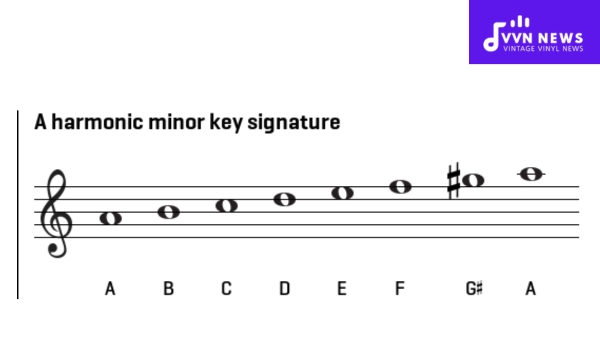
Yet, what makes it distinctive is its raised seventh degree. If you dig into the anatomy of this scale, it comprises the notes: A, B, C, D, E, F, and G#.
The elusive G# raises intrigue as it introduces an augmented second interval between the sixth and seventh steps, dictating a ‘leading tone’ back to tonic A.
This highlights a sense of resolution in music orchestrated around this scale; subsequently elevating its intrigue among composers.
Also Read: E Major: Scale And Chords [Exciting Sounds For Your Compositions]
Notation of A Harmonic Minor in various clefs?
Should music notation ever make you feel like you’ve encountered a foreign language, then just remember this: It’s simply a way of expressing sound on paper or digitally.
Don’t let those peculiar symbols intimidate you! By knowing how to decode the secret language of the harmonic minor scale in various clefs, your musical literacy will reach new heights!
Let’s dive into the ocean of music theory and learn A Harmonic Minor notation for different clefs: Treble, Bass, Alto, and Tenor.
Treble Clef
The A harmonic minor in treble clef begins on the second space from the bottom of the staff with A.
It then ascends to B, C, D, E, and F, and surprisingly steps up to G# before finding its resolution at A again.
In print and manuscript alike, these notes will grace the spaces and lines of the treble clef in this order.
Bass Clef
Erasing any doubts about transposition between clefs, the harmonious notes of this scale in bass clef start on middle A (the 1st ledger line above the stave), ascending to B (2nd line from bottom), C (2nd space from bottom), D (3rd line from bottom), E (3rd space from bottom), F remained stationary on top line.
G is sharpened to G# (1st ledger below) promptly returning to an octave higher, A.
Alto Clef
In an alto clef context – a rarity utilized chiefly by violists – middle “C” sits smack in its center.
Consequently, for an Alto stave presentation of A harmonic minor scale; we begin with A (bottom line) progressing through B and C right up to E; then carrying on from F down below step up again at G sharp ending one octave up with “A”.
Tenor Clef
The tenor clef is often employed by trombonists and bassoonists as their trusted accomplice.
As a matter of factually aligning your musical vision here: envision an ascending sequence starting at “A” that’s located as 2nd ledger line; you’ll find it curls back to meet “A” which is lying restfully just below the stave’s uppermost line.
Needless to say – your weapon of choice is Treble or Bass; Alto or Tenor – once you master the A harmonic minor scale notation within these clefs, you kick open a whole universe of musical pieces to explore and, inevitably create!
Also Read: Roman Numeral Chords Explained: Transform Your Music!
Chords within the A Harmonic Minor Scale
To fully appreciate the A Harmonic Minor scale, we need to dive into its chords.
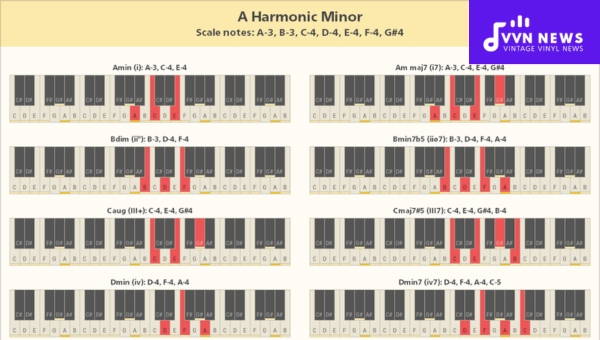
In every scale, each degree or note can be used to form a chord, and the A Harmonic Minor scale is no exception.
Here’s the breakdown:
- A minor (Am): A–C–E
- B diminished (Bdim): B–D–F
- C augmented (Caug): C–E–G♯
- D minor (Dm): D–F–A
- E major (E): E-G♯-B
- F major (F): F-A-C
- G♯ diminished/G♯ minor7b5(G♯dim/G♯m7b5): G♯-B-D-F
The chords above reflect every nuance of this scale and provide a beautiful layering system for you to compose or improvise music within this interesting minor key.
Also Read: A Minor Scale [Unlock The Mysteries Of Musical Composition]
FAQs
What is the peculiarity of the A harmonic minor scale?
The A harmonic minor scale is unique due to its raised seventh degree, a feature that sets it apart from natural minor scales and creates a distinctive sound profile.
How does the A Harmonic minor scale work in music composition?
A harmonic minor scale is particularly effective in establishing tension and resolution, making it invaluable for melodic compositions and improvisations.
What is the difference between an A harmonic minor scale and an A natural minor scale?
The key difference between a harmonic minor scale and a natural minor scale lies within their seventh note – in the harmonic version, it is raised by half a step.
In what genres of music is the A Harmonic Minor commonly used?
While versatile enough to span across numerous genres, the A-harmonic minor scale finds extensive use, particularly in classical, jazz, metal, gypsy tunes, and even pop.
Can beginners learn the A Harmonic Minor Scale?
Absolutely! The complexity of this scale may vary but with persistent practice and understanding of its progression, even beginners can master it over time.
Also Read: D Sharp Major Pentatonic Scale [A Bright And Positive Tone]
Conclusion
One often ponders over the essence of an A Harmonic Minor Scale. You must remember that it’s more than a collection of subsequent notes. It’s the backbone of numerous compositions – a key to unlocking an array of emotions.
Acting as a pillar of your musical journey, using this harmonic minor scale will help you comprehend and construct melodies like never before. So, if you’re an aspiring musician or a professional, make sure not to overlook this distinctive scale in your symphony of exploration.
